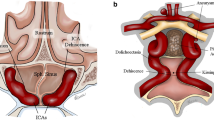Abstract
The prevalence of cerebral aneurysm was retrospectively investigated in 208 patients with acromegaly relative to the rate of cerebral aneurysm in a group of control subjects. Neuroradiological examinations of the cerebral vascular system were conducted in 208 acromegaly patients (101 men; mean age, 48.8 years). The prevalence of cerebral aneurysm in the acromegaly patients was compared to that in a control group consisting of 7,390 subjects who underwent “brain checkup” between 2006 and 2008 (mean age, 51.6 years). In the acromegaly group, cerebral aneurysm was detected in 4.3 % of patients. By sex, the prevalence was 6.9 % in males, a significantly proportion than that in the control group with an odds ratio of 4.40. The prevalence in females did not differ between the two groups. In the acromegaly group, the rate of hypertension was significantly higher in the patients with aneurysm compared to those without aneurysm. Multiple logistic regression identified acromegaly as a significant factor related to the prevalence of cerebral aneurysm in all male subjects; other factors, such as age, hypertension and smoking, were not found to be significant. A significantly higher prevalence of cerebral aneurysm was detected in male patients with acromegaly. This finding indicates that excess growth hormone or insulin-like growth factor 1 affects the cerebral vascular wall, resulting in aneurysm formation. In addition to known systematic complications in the cardiovascular, respiratory, metabolic, and other systems, the risk of cerebral aneurysm should be considered in the management of acromegaly.


Similar content being viewed by others
References
Colao A, Ferone D, Marzullo P, Lombardi G (2004) Systemic complications of acromegaly: epidemiology, pathogenesis, and management. Endocr Rev 25(1):102–152
Jakubowski J, Kendall B (1978) Coincidental aneurysms with tumours of pituitary origin. J Neurol Neurosurg Psychiatry 41(11):972–979
Acqui M, Ferrante L, Fraioli B, Cosentino F, Fortuna A, Mastronardi L (1987) Association between intracranial aneurysms and pituitary adenomas. A Etiopathogenetic hypotheses. Neurochirurgia (Stuttg) 30(6):177–181
Pant B, Arita K, Kurisu K, Tominaga A, Eguchi K, Uozumi T (1997) Incidence of intracranial aneurysm associated with pituitary adenoma. Neurosurg Rev 20(1):13–17
Weir B (1992) Pituitary tumors and aneurysms: case report and review of the literature. Neurosurgery 30(4):585–591
Zatelli MC, Scanarini M, Bondanelli M, Ambrosio MR, degli Uberti EC (2004) Cerebral aneurysm and acromegaly: a case report. J Endocrinol Invest 27(8):770–773
Curto L, Squadrito S, Almoto B, Longo M, Granata F, Salpietro F, Torre ML, Marini F, Trimarchi F, Cannavo S (2007) MRI finding of simultaneous coexistence of growth hormone-secreting pituitary adenoma with intracranial meningioma and carotid artery aneurysms: report of a case. Pituitary 10(3):299–305
Manara R, Maffei P, Citton V, Rizzati S, Bommarito G, Ermani M, Albano I, Della Puppa A, Carollo C, Pavesi G, Scanarini M, Ceccato F, Sicolo N, Mantero F, Scaroni C, Martini C (2011) Increased rate of intracranial saccular aneurysms in acromegaly: an MR angiography study and review of the literature. J Clin Endocrinol Metab 96(5):1292–1300
Yoshimoto Y (2006) A mathematical model of the natural history of intracranial aneurysms: quantification of the benefit of prophylactic treatment. J Neurosurg 104(2):195–200
Tanimoto K, Hizuka N, Fukuda I, Takano K, Hanafusa T (2008) The influence of age on the GH-IGF1 axis in patients with acromegaly. Eur J Endocrinol 159(4):375–379
Wardlaw JM, White PM (2000) The detection and management of unruptured intracranial aneurysms. Brain 123(Pt 2):205–221
Ellamushi HE, Grieve JP, Jager HR, Kitchen ND (2001) Risk factors for the formation of multiple intracranial aneurysms. J Neurosurg 94(5):728–732
Harrod CG, Batjer HH, Bendok BR (2006) Deficiencies in estrogen-mediated regulation of cerebrovascular homeostasis may contribute to an increased risk of cerebral aneurysm pathogenesis and rupture in menopausal and postmenopausal women. Med Hypotheses 66(4):736–756
Horiuchi T, Tanaka Y, Hongo K (2006) Sex-related differences in patients treated surgically for aneurysmal subarachnoid hemorrhage. Neurol Med Chir (Tokyo) 46(7): 328–332, discussion 332
Horikoshi T, Akiyama I, Yamagata Z, Nukui H (2002) Retrospective analysis of the prevalence of asymptomatic cerebral aneurysm in 4518 patients undergoing magnetic resonance angiography–when does cerebral aneurysm develop? Neurol Med Chir (Tokyo) 42(3): 105–112, discussion 113
Schwab KE, Gailloud P, Wyse G, Tamargo RJ (2008) Limitations of magnetic resonance imaging and magnetic resonance angiography in the diagnosis of intracranial aneurysms. Neurosurgery 63(1): 29–34, discussion 34–25
Kulseng B, Myhre HO (2006) Is insulin growth factor-1 (IGF-1) playing a role for aneurysm formation in patients with pituitary gland tumor? Int Angiol 25(4):433–435
Maffei P, Menegazzo C, Michelotto M, Salmaso R, Martini C, De Carlo E, Carli M, Barban M, Fassina A, Vettor R, Sicolo N (2008) Sudden death due to aortic rupture in acromegaly. Heart Vessels 23(1):71–74
Yamamoto T, Kurosaka M, Sugimoto T (2001) A true aneurysm of the femoral artery in acromegaly. Clin Imaging 25(2):126–129
Izgi C, Cevik C, Nugent K (2010) Annuloaortic ectasia and ascending aortic aneurysm as a cardiovascular manifestation of acromegaly. Cardiovasc Intervent Radiol 33(2):438–440
Acqui M, Ferrante L, Matronardi L, d’Addetta R (1988) Alteration of the collagen type III/type I ratio and intracranial saccular aneurysms in GH-secreting hypophyseal adenomas. Ital J Neurol Sci 9(4):365–368
Paisley AN, O’Callaghan CJ, Lewandowski KC, Parkinson C, Roberts ME, Drake WM, Monson JP, Trainer PJ, Randeva HS (2006) Reductions of circulating matrix metalloproteinase 2 and vascular endothelial growth factor levels after treatment with pegvisomant in subjects with acromegaly. J Clin Endocrinol Metab 91(11):4635–4640
Izgi C, Cevik C, Nugent K (2010) Annuloaortic ectasia and ascending aortic aneurysm as a cardiovascular manifestation of acromegaly. Cardiovasc Intervent Radiol 33(2):438–440
Acknowledgments
The authors thank to Ms. Sachiko Yamasaki for her help in collection the data of brain checkup, and also thanks to Mrs. Keiko Takeoka for technical comments based and her excellent work in clinical laboratory.
Ethical standards
This study was approved by the Ethical Committee of Osaka University Hospital (No. 10100).
Conflict of interest
The authors declare that they have no conflict of interest.
Author information
Authors and Affiliations
Corresponding author
Rights and permissions
About this article
Cite this article
Oshino, S., Nishino, A., Suzuki, T. et al. Prevalence of cerebral aneurysm in patients with acromegaly. Pituitary 16, 195–201 (2013). https://doi.org/10.1007/s11102-012-0404-x
Published:
Issue Date:
DOI: https://doi.org/10.1007/s11102-012-0404-x




